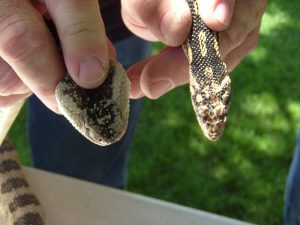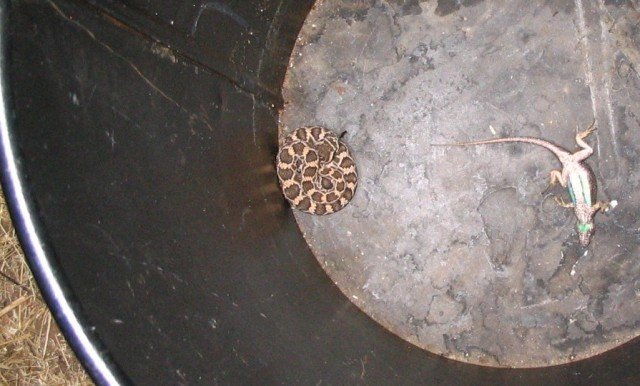I have a follow-up post on this subject here with a further discussion and bibliography with Dr. Hayes and another here on more recent research by Dr. Erika Nowak.
We were up at a Big Bear concert a couple weekends ago, which was sponsored by the San Bernardino National Forest Association (great time – one more concert Sep 1st), and director Sarah Miggins told us they removed a rattlesnake during the concert that was coiled up under the sound stage. Oblivious to the hundreds of attendees, a U.S. Forest Service biologist successfully captured the snake, placed in a garbage can, and released it some distance away.
It was likely glad to get away from all the noise. And thank goodness, as one security person was about to use a fire extinguisher on the snake.
I’ve written about rattlesnakes before (see Some Truths about Rattlesnakes (and Myth Debunking) and It’s Springtime for Rattlers and other Snakes) – my goal is to dispel the fear about them. This seems an appropriate time to say once again that rattlesnakes should not be killed. Except for a few rare exceptions, they just want to get away from humans. (we encountered one in Oak Creek Canyon outside Sedona that would not leave the trail area so we had to make a pretty large detour)

I checked with my friendly snake expert, Dr. William Hayes of Loma Linda University, and he corrected some misinformation about relocation.
- The belief that relocated (translocated) snakes are as good as dead –that they are consigned to death if taken elsewhere and removed — is NOT true. According to Hayes, there is some evidence showing some don’t do well, especially those moved far distances, but studies have shown “eventually the snake settles into its new digs and can be successful. There’s a very reasonable chance that the translocated snake will fare okay.
Certainly, translocation is a far more reasonable option than being killed.” Dr. William Hayes, Professor of Biology, Loma Linda U
Hayes also reiterated the following:
- Rattlesnakes and other snakes play vital roles in limiting the size of rodent populations
Use common sense if you see a rattlesnake – or any snake. Move away from it, and it often leaves the area. For removal, call your the fire department or animal control number in your area – it varies which one is equipped to do the removal. We have removed small rattlers that were near our San Diego house by using a long stick to usher them into a big container before relocating them down the canyon. (See photo) But it’s best to call the experts.

- If you get bit, get to the hospital immediately. There’s no exact data but about 3500 to 4000 in the U.S get bit by rattlesnakes annually. The approximate five that die occurred between 6 and 48 hours after the bite. If anti-venom treatment is given within 1–2 hours of the bite, the probability of recovery is greater than 99%.
- If your dog gets bit (150,000 dogs is one annual estimate) many survive without treatment — my husband’s springer spaniel did — but some don’t. Getting bit in eye, mouth, ear area, or chest is more serious. A vet bill for anti-venom treatment can add up to $1500 or more. Consider snake-training for your dog. Search online for ‘dog snake training’ or call a dog trainer. And if you live in rattlesnake country, consider a vaccination for your dog.
Correcting More Misinformation about Rattlesnakes:
Hayes says research shows it is NOT true that baby rattlesnakes are more dangerous than adult rattlesnakes. Reality: There is no published data to suggest that baby rattlers inject more venom or that they lack control of how much venom they expend. See How Dangerous Are Baby Rattlesnakes?
And it is NOT true that rattlesnake venoms are rapidly evolving to become more toxic. See Sensationalistic Journalism and Tales of Snakebite. There is a research article claims there is rapid evolution of venom, but Hayes said “the time scale is far, far greater than decades.”
For More Info: Biologyof theRattlesnakes.com
William K Hayes, PhD – [email protected] Phone 909-558-4300 (ext 48911)
My personal opinion: If you choose to live in a home on the edge of natural areas, or hike in those areas, learn to live with the others who make it their home.
With regard to:
?The belief that relocated (translocated) snakes are as good as dead
I forwarded the comment above to Dr. Hayes, who just returned from a vacation – and received the following. He also provided a long annotated bibliography which I’ll post later but contact me if you want a copy for now:
From Dr. Hayes: As I stated and Linda wrote, snakes do travel more the first year after release and suffer higher mortality, but many do survive and settle down in time.
There are just four options for dealing with “nuisance” rattlesnakes: (1) leave them alone (many homeowners won’t accept this); (2) kill them (I don’t like this option); (3) translocate them to another area and let them have a chance to live; (4) remove them from the wild and keep them in captivity for the rest of their lives. I personally think option #3 is perfectly legitimate and much preferable to and more humane than option #2. If you wish to interpret the published studies differently than I do, you’re welcome to do so.
Thanks Linda. I received a copy of the e-mail with the bibliography from Dr. Hayes. I’ll mention to folks in our discussion thread that it will be available here.
One aspect that has not been brought up is the legality of relocation: laws vary from state to state, and in some snakes are also protected federally.
I’m a licensed wildlife agent in North Carolina. Here the law is twofold:
1) Snakes are able to be relocated because they are not a rabies vector species
2) the area that a snake(s) is released is only legal to do so if you have explicit permission from the owner of that land/property.
So if you put a snake in a bucket and you drive down the road and see what you think look to be a lovely forest and relocate the snake there well most likely someone owns that property and you are breaking the law.
Also, people think that they can release Snakes in public Parks – Wildlife can only be released in public Parks with written permission.
Once a Rattler is covered with a towel or sheet, they quite down. We keep a large plastic clothing bin with a locking lid for just relocation of snakes. A metal trash can is perfect, but when we needed something, we use a large clothing bin. I found a 2 footer in my kitchen. Youtube taught me what to do. 1)-Stay calm, throw 2 towels from different directions on snake. Cover with a box. Slide the clothing bin lid (smooth side against floor to allow easy sliding) under the towels & box while keeping pressure on the box the snake is under. I used a hamburger flipper to carefully tuck the towel completely under the box before picking up the lid/box/snake combination. Then we carefully flipped the entire collection into the large plastic clothing bin that we had bought at the Dollar Store. Relocate them at least 25 miles away from your home with no people around. Happy snake & happy you! Happened to us Oct 2015.
We have relocated approximately 50 rattlesnakes in the last 5 years.
The best way to remove them is to use a set of padded 5 or 6 ft tongs which are available on the internet. Simple grasp them and place them into an empty plastic garbage can with a locking ! lid. One we caught was able to make his way to the top of the can and sneak away. They can stand upright on the lower portion of their bodies! Make sure you place the garbage can in your garage or other 24 hr shaded area. If the sun hits the garbage can the snake will die within hours from the heat. Plastic is best as it does not heat up as much as metal would in your garage/holding area. Then when you have time take it to a remote area and fling it into the brush.
Also, if you have a lot of snakes around, a couple cans is not a bad idea. We caught 3 in a row once within a 24 hr period.
Thank you Dan for writing in about your relocation practices, very helpful.